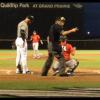Ball hit twice
Umpire-Empire locks topics which have not been active in the last year. The thread you are viewing hasn't been active in 2798 days so you will not be able to post. We do recommend you starting a new topic to find out what's new in the world of umpiring.
-
Similar Content
-
Very weird type 1 obstruction play, Brewers manager ejected 1 2
By Gfoley4,
- obstruction
- pirates
- (and 1 more)
- 46 replies
- 4,935 views
-
- 17 replies
- 1,838 views
-
- 11 replies
- 2,653 views
-
- 11 replies
- 1,506 views
-
- 37 replies
- 3,277 views
-




Recommended Posts